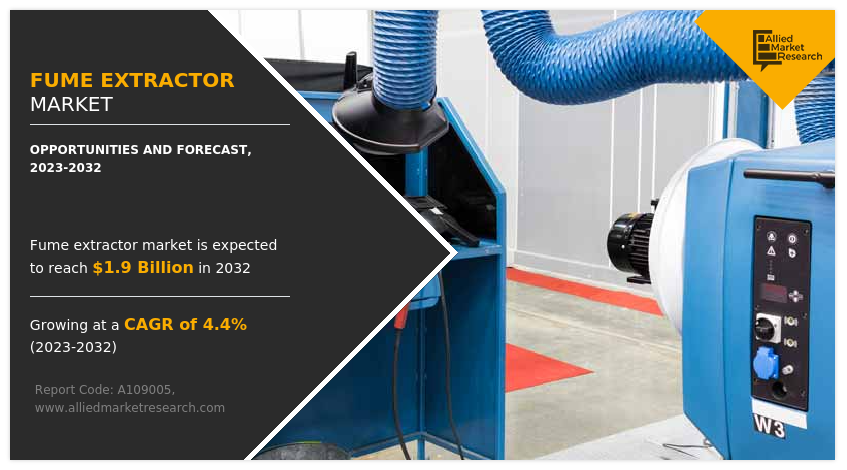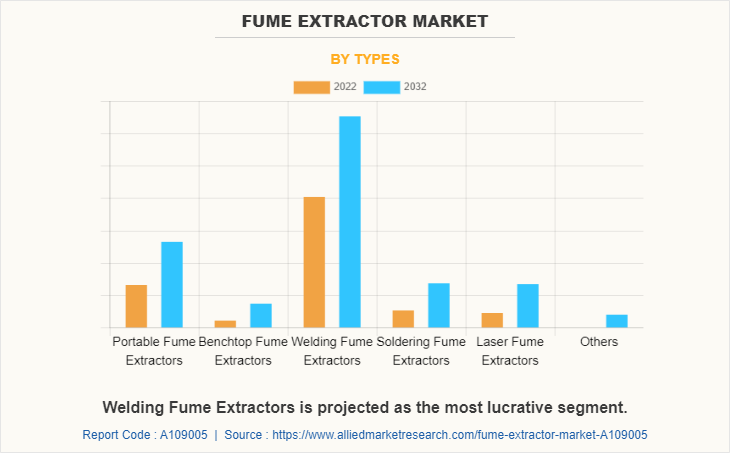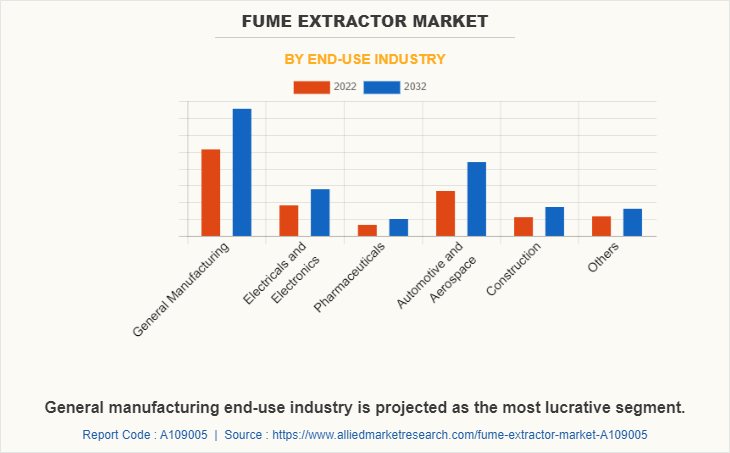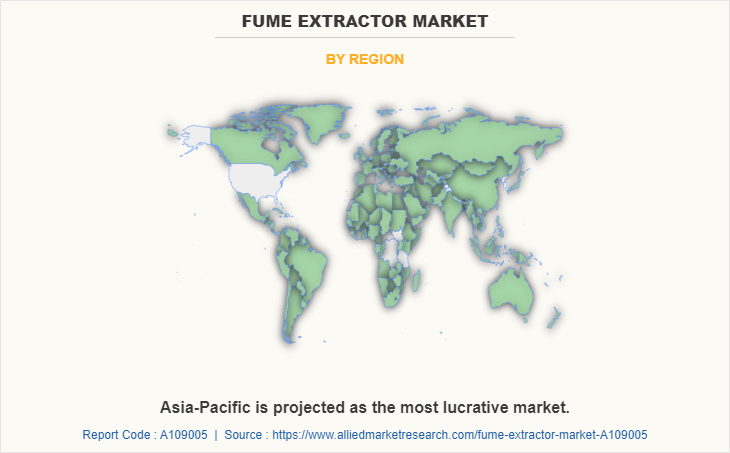Fume Extractor Market Research, 2032
The global fume extractor market was valued at $1.3 billion in 2022, and is projected to reach $1.9 billion by 2032, growing at a CAGR of 4.4% from 2023 to 2032.

A fume extractor, also known as a fume hood or exhaust hood, is a device used to remove potentially harmful gases, vapors, dust, or fumes from an enclosed space. It is commonly used in laboratories, industrial settings, and manufacturing facilities where various chemicals or processes generate airborne contaminants. The primary purpose of a fume extractor is to protect the health and safety of individuals working with or around hazardous substances. By capturing and removing airborne pollutants at their source, it helps prevent their inhalation, minimizing the risk of respiratory problems, chemical exposure, or fire hazards.
Fume extractors consist of an enclosure or hood that surrounds the area where the contaminants are generated. The hood is connected to a ventilation system that draws air from the workspace, capturing the pollutants within the enclosure. The contaminated air is then filtered or exhausted outside the building, effectively removing the harmful substances.
Furthermore, fume extractors are particularly beneficial in industries where hazardous materials are used or generated, such as laboratories, chemical manufacturing, pharmaceuticals, and metalworking. These extractors ensure that hazardous substances are contained and properly disposed of, preventing their release into the environment and minimizing the risk of accidents or incidents. Moreover, many industries are subject to strict health and safety regulations that mandate the use of fume extraction systems. By implementing a fume extractor, businesses can demonstrate compliance with these regulations and avoid potential penalties or legal issues.
The growth of the global fume extractor market is majorly driven by an increase in occupational health and safety regulations. Governments and regulatory bodies are implementing stricter regulations to protect the health and safety of workers. These regulations often require the use of fume extractors or similar ventilation systems in industries where hazardous substances are present. The growing emphasis on workplace safety is driving the demand for fume extractors.
There is a greater understanding of the potential health risks associated with exposure to airborne contaminants, such as chemicals, dust, and fumes. Both employers and employees are becoming more aware of the importance of controlling and minimizing exposure to these hazards. Fume extractors are recognized as an effective solution for reducing exposure, which has contributed to their increased adoption.
Increase in demand for fume extractors in several industries
The industries such as chemicals, pharmaceuticals, electronics, automotive, and metalworking are expanding globally. With the growth of these industries, the need for fume extraction systems is expected to increase simultaneously to control and remove hazardous fumes, gases, and dust generated during production processes. Fume extractors play a crucial role in maintaining a safe working environment.
Industrial & manufacturing sector: The industries such as chemical manufacturing, pharmaceuticals, electronics, metalworking, and automotive often involve processes that generate hazardous fumes, gases, or dust. Fume extractors are essential in these industries to control and remove these airborne contaminants, ensuring worker safety and compliance with environmental regulations.
Laboratories & research facilities: Laboratories, research centers, and educational institutions require fume extractors to maintain a safe working environment. These facilities deal with a wide range of chemicals, volatile substances, and potentially harmful fumes. Fume extractors are necessary to protect researchers, prevent cross-contamination, and maintain the integrity of experiments.
Health & Healthcare Facilities: Hospitals, clinics, and healthcare facilities require fume extractors to address various scenarios, such as surgical smoke extraction, laboratory testing, chemical storage areas, and isolation rooms. Fume extractors play a crucial role in removing harmful substances and ensuring the well-being of patients, staff, and visitors.
Metal Fabrication & Welding: Metal fabrication and welding processes generate smoke, fumes, and particulate matter that can be hazardous to workers. Fume extractors are employed to capture and filter these contaminants, reducing the risk of respiratory issues and improving the overall air quality in the work environment.
Woodworking & Carpentry: Woodworking activities produce wood dust, which can pose respiratory hazards and create fire risks. Fume extractors with dust collection capabilities are used in woodworking shops and carpentry workshops to capture and remove fine wood particles, protecting workers' health, and maintaining clean workspaces.
Printing & 3D Printing: Printing processes, including traditional printing and 3D printing, can release harmful volatile organic compounds (VOCs) and particles. Fume extractors are employed to capture and filter these emissions, ensuring worker safety and preventing air pollution in the printing environment.
Food & Beverage Industry: Fume extractors are used in commercial kitchens and food processing facilities to remove smoke, grease, steam, and odors generated during cooking and food preparation. These extractors help maintain a clean and comfortable working environment while ensuring the quality and safety of food products.
Energy & Power Generation: Power plants, refineries, and energy generation facilities often produce gases, fumes, and particulates during their operations. Fume extractors are utilized to control and remove these pollutants, promoting a healthier work environment and minimizing the impact on surrounding areas.
Mining & Construction: The industries such as mining and construction involve activities that generate dust, fumes, and hazardous particles. Fume extractors are used to capture and filter these airborne contaminants, protecting workers from respiratory issues and maintaining air quality on construction sites and mining operations.
The demand for fume extractors in these industries is driven by the need to ensure worker health and safety, comply with regulations, maintain clean work environments, and reduce the impact of airborne contaminants on both employees and the surrounding environment.
The global fume extractors market is segmented into type, end-use industry, and region. By type, the market is segregated into portable fume extractors, benchtop fume extractors, welding fume extractors, soldering fume extractors, laser fume extractors, and others. On the basis of end-use industry, it is categorized into general manufacturing, electricals & electronics, pharmaceuticals, automotive & aerospace, construction, and others. Region wise, the market is analyzed across North America, Europe, Asia-Pacific, and LAMEA.
The major players operating in the industry include American Air Filter Company, Inc., APZEM Inc., Cleantek, Sentry Air Systems, Inc., Quatro Air Technologies Inc., HAKKO Corporation, Apollo Seiko, Span Filtration Systems Pvt. Ltd., Powertech Pollution Controls, and Donaldson Company, Inc. These players have adopted product launch as their key strategy to strengthen their presence in the market.

Based on type, the welding fume extractors segment dominated the largest market share in 2022 due increasing emphasis on workplace safety and health regulations across industries. Welding produces hazardous fumes and particles that can pose serious health risks to workers if inhaled. Welding fume extractors help remove these pollutants from the air, ensuring a safer working environment and reducing the potential for respiratory issues and long-term health problems.

Based on end-use industry, the general manufacturing segment dominated the largest market share in 2022 due to growing recognition of the importance of providing a safe working environment for employees. Manufacturers are becoming more aware of the potential health hazards associated with various manufacturing processes, including welding, soldering, grinding, and cutting. Fume extractors play a crucial role in removing harmful fumes, gases, and particulate matter from the air, thereby protecting workers' health.

Based on region, the Asia-Pacific region dominated the highest market share in 2021 due to the highly developed electronic sector in China and the continuous investments are done in the region through the years to advance the electronic sector.
Key Benefits For Stakeholders
- This report provides a quantitative analysis of the market segments, current trends, estimations, and dynamics of the fume extractor market analysis from 2022 to 2032 to identify the prevailing fume extractor market opportunities.
- The market research is offered along with information related to key drivers, restraints, and opportunities.
- Porter's five forces analysis highlights the potency of buyers and suppliers to enable stakeholders make profit-oriented business decisions and strengthen their supplier-buyer network.
- In-depth analysis of the fume extractor market segmentation assists to determine the prevailing market opportunities.
- Major countries in each region are mapped according to their revenue contribution to the global market.
- Market player positioning facilitates benchmarking and provides a clear understanding of the present position of the market players.
- The report includes the analysis of the regional as well as global fume extractor market trends, key players, market segments, application areas, and market growth strategies.
Fume Extractor Market Report Highlights
| Aspects | Details |
| Market Size By 2032 | USD 1.9 billion |
| Growth Rate | CAGR of 4.4% |
| Forecast period | 2022 - 2032 |
| Report Pages | 250 |
| By Types |
|
| By End-use Industry |
|
| By Region |
|
| Key Market Players | CLEANTEK, Apollo Seiko, APZEM Inc, Quatro Air Technologies Inc., Donaldson Company, Inc., Powertech Pollution Controls Pvt Ltd, American Air Filter Company, Inc., Sentry Air Systems, Inc., Span Filtration Systems Private Limited, HAKKO Corporation |
Analyst Review
As per the insights of the top-level CXOs, fume extractors are gaining high traction across various industries, including manufacturing, pharmaceuticals, chemicals, and research laboratories. As new facilities are established and existing ones are upgraded, there is a higher demand for fume extractors to ensure worker safety, regulatory compliance, and environmental protection. The development of infrastructure projects further drives the need for fume extraction systems in the construction and engineering sectors. Furthermore, there is a growing emphasis on sustainable practices and reducing the environmental impact across industries. Thus, companies are increasingly adopting fume extraction systems to align with their corporate social responsibility initiatives and sustainability goals.
The CXOs further added that the outbreak of the COVID-19 pandemic has highlighted the importance of maintaining clean and healthy indoor environments. Fume extractors play a role in reducing the spread of airborne contaminants, including viruses and bacteria, in various settings. This has led to increased awareness and demand for fume extraction systems in healthcare facilities, offices, and public spaces.
Surge in demand for fume extractors from the manufacturing sector will drive the market growth during the forecast period.
General Manufacturing is the leading application of the Fume Extractor Market.
Asia-Pacific is the largest regional market for Fume Extractor.
The global fume extractor market was valued at $1.3 billion in 2022, and is projected to reach $1.9 billion by 2032, growing at a CAGR of 4.4% from 2023 to 2032.
The major players operating in the industry include American Air Filter Company, Inc., APZEM Inc., Cleantek, Sentry Air Systems, Inc., Quatro Air Technologies Inc., HAKKO Corporation, Apollo Seiko, Span Filtration Systems Pvt. Ltd., Powertech Pollution Controls, and Donaldson Company, Inc. These players have adopted product launch as their key strategy to increase their market shares.
Loading Table Of Content...
Loading Research Methodology...



